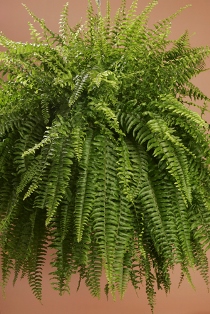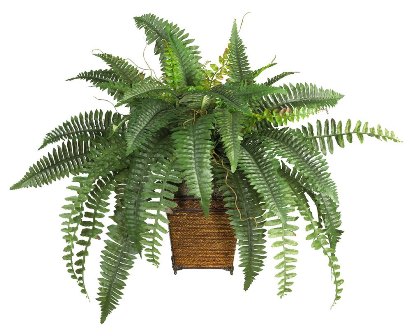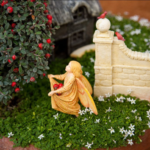Boston Fern: Growing Nephrolepis exaltata
Of all ferns suitable for indoor growing, Boston fern is one of the easiest to grow successfully. Whereas some ferns wither up and die in the dry air typical in many homes, Boston fern thrives. Even better, this plant is one of the top choices for cleaning indoor air.

(Chas Metivier, HealthyHouseplants.com)

(Jay Neill, FreeImages.com)
Featuring ruffled, sword-like, lime-green fronds, Boston fern creates an eye-catching display in a hanging basket. It also looks good cascading from a perch, such as from the top of a bookcase or entertainment center.
Botanically known as Nephrolepis exaltata ‘Bostoniensis,’ Boston fern has been around for more than 100 years. The species from which Boston Fern comes from originates from a fern that is native throughout Florida and can be found around the Pacific Rim in tropical areas.
The Boston Fern was discovered in a shipment of 200 plants back in 1894. The shipment was going from a Philadelphia florist to F.C. Becker, a florist in Cambridge, Massachusetts.
Becker noticed the plant, which was unusual in that it had wider fronds than many other ferns and an attractive hanging habit, instead of upright, stiff fronds. He singled out the plant and began propagating it.
Two years later, London botanists identified the plant as Nephroplesis exaltata and suggested naming the cultivar ‘Bostoniensis’ because it was discovered near Boston by Becker and propagated by him.
To have luck with Boston fern, keep the following growing tips in mind.
Provide proper lighting for Boston Fern
Boston ferns do best in an unobstructed northern window that receives medium, indirect light throughout the day, or in an eastern-facing window that gets morning light. Avoid placing Boston fern in a south- or west-facing window, as such locations are generally too bright and will burn the plant’s foliage.
Watch room temperature
Like most ferns, Boston fern requires a room temperature between 65 to 75 degrees in the day and 10 degrees cooler at night. If temperatures are higher, the plant may do okay but will require more frequent watering. Temperatures below 65 degrees for extended periods of time tend to result in stunted or slow growth.

Keep moist
Boston fern does not respond well to drying out, so make sure to keep the plant evenly moist, but not soggy. Perpetually soggy soil will lead to yellowing fronds and can result in root rot.
Provide extra humidity
Although Boston fern responds well to the low humidity in most homes, it does best with a little extra moisture in the air. If you live in a dry climate, mist the plant on a daily basis and place Boston fern near other plants. The more plants you have grouped together, the more humid the surrounding air will be.
Plant in rich soil
Boston ferns require a soil that is rich in organic matter, such as compost. Repot yearly with an organic potting soil that is 50 percent peat moss and contains compost. In addition to adding regular compost, use vermicompost.
Fertilize monthly
Provide consistent nutrients to your Boston fern by feeding the plant with an all-purpose organic plant food monthly from April through October. This will keep the plant full and lush with plenty of new fronds.
Watch for pests
Boston ferns rarely suffer from infestations, but it’s a good idea to keep an eye out for a few annoying invaders, including mealybugs, mites and scale insects. Mealybugs can be destroyed by spraying with isopropyl alcohol (rubbing) and then rinsing the plant off. Mites can be avoided by making sure to keep the plant misted and the soil moist, as this pest thrives in dry conditions. And if you find scale insects on your ferns, cut off affected fronds. If there are too many to remove, treat with 91 or 70 percent isopropyl alcohol. Let sit for 30 minutes, rinse, and treat with neem oil.





